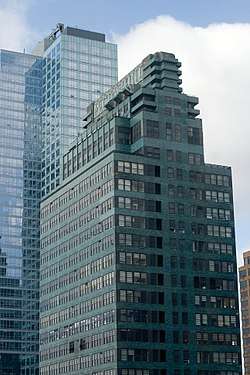330 West 42nd Street
The McGraw Hill Building at 330 West 42nd Street is a 35-story, 485-foot-tall (148 m) building[6] located in the Hell's Kitchen section of Manhattan, New York City.
McGraw Hill Building | |
 | |
   | |
| Location | 330 West 42nd Street Manhattan, New York City, New York[1][2] |
|---|---|
| Coordinates | 40°45′26.5″N 73°59′30″W |
| Built | 1931 |
| Architect | Raymond Hood[3] |
| Architectural style | International Style, Art Deco, Art Moderne[4] |
| NRHP reference No. | 80002701 |
| Significant dates | |
| Added to NRHP | March 28, 1980[1] |
| Designated NHL | June 29, 1989[5] |
| Designated NYCL | September 11, 1979 |
The exterior walls of the building are panels of blue-green terracotta ceramic tiles, alternating with green-metal-framed windows, with a strongly horizontal orientation. The building was the only skyscraper in the city displayed in the influential International Style exhibition at the Museum of Modern Art in 1932, and as such, it has also been cited as a landmark of Art Deco design. Located on West 42nd Street, between Eighth and Ninth Avenues, above the Port Authority Bus Terminal, the McGraw-Hill Building was the tallest building in the Hell's Kitchen neighborhood for decades, but lost that status with the construction of One Worldwide Plaza eight blocks to the north. It is still visible from a distance, but is dwarfed by the newly constructed Orion, a 58-story residential complex with a green exterior to its west on the same block.
History
McGraw-Hill Companies bought the land in early 1930 as they were outgrowing their previous McGraw-Hill Building (Hill Publishing Building) at 475 Tenth Avenue. The building was designed by Raymond Hood. Construction began on December 1930 with the first rivet driven and was completed in 1931. McGraw-Hill moved into the building in October 1931. Printing operations occupied the lower floors to the sixth with the bindery on the fifth, press room on the sixth and composing room on the seventh floor. The ninth through 15th floors were rented out.[6]
Pulp publisher Martin Goodman was based here by 1939. In that year, Goodman started up Timely Comics, Marvel Comics’ Golden Age common name. Timely later moved to the Empire State Building, Suite 1401.[7]
As the street declined, the building was more of a liability. McGraw-Hill moved out in 1972 to a new McGraw-Hill Building at 1221 Avenue of the Americas, while selling this building,[6] which was subsequently declared a National Historic Landmark in 1989.[4][5]
An angular metal sculpture, Boomerang, by the artist Owen Morrel was suspended on the side of the building. After several owners, Deco Towers Associates, a foreign investment group, became the owner in 1994. In 1998, a restoration of the building began and Boomerang was dismantled for recycling or junking.[6]
See also
References
- "National Register Information System". National Register of Historic Places. National Park Service. January 23, 2007.
- AIA Guide to New York City, 4th edition, page 254
- McGraw Hill Building Archived June 5, 2011, at the Wayback Machine, National Historic Landmarks, Accessed October 30, 2010.
- Pitts, Carolyn. (February 9, 1989) National Register of Historic Places Registration: McGraw Hill Building, National Park Service and Accompanying 8 photos, exterior and interior, from 1984.
- "McGraw Hill Building". National Historic Landmark summary listing. National Park Service. September 15, 2007. Archived from the original on June 5, 2011. Retrieved September 16, 2007.
- Gray, Christopher (March 14, 1999). "Streetscapes /The Old McGraw-Hill Building; A Color-Filled Restoration of a Colorful Skyscraper". The New York Times. Retrieved October 8, 2019.
- Sanderson, Peter (2007). The Marvel Comics Guide to New York City. Simon and Schuster. p. 59. ISBN 978-1-4165-3141-8.
| Wikimedia Commons has media related to 330 West 42nd Street. |

